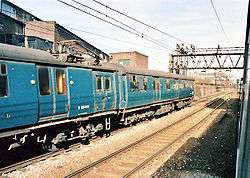British Rail Class 306
| British Rail Class 306 | |
|---|---|
|
The preserved Class 306 train (unit 017) as seen on the launch day of Network SouthEast. This view also shows the carriage which was not modified when the trains were converted from the DC to the AC power supply system. | |
| In service | 1949 - 1981 |
| Manufacturer | Metro Cammell and BRCW |
| Constructed | 1949[1] |
| Refurbishment | 1960-1961[2] |
| Number built | 92 trainsets |
| Formation |
|
| Design code | AM6 |
| Fleet numbers |
|
| Capacity |
|
| Operator(s) | British Rail |
| Depot(s) | Ilford[1] |
| Line(s) served | Shenfield Line[4] |
| Specifications | |
| Train length | 177 ft 7 in (54.13 m)[2] |
| Car length | |
| Width | 9 ft 3 in (2.82 m)[5] |
| Height | 13 ft 1 in (3.99 m)[2] |
| Doors | Bi-parting sliding[2] |
| Articulated sections | 3 |
| Maximum speed | 75 mph (121 km/h)[2] |
| Weight |
|
| Traction motors | 4 × EE 504[5] |
| Power output | 4 × 210 hp (160 kW)[5] |
| Electric system(s) |
|
| Current collection method | Pantograph |
| UIC classification | Bo'Bo'+2'2'+2'2' |
| Bogies | Thompson[7] |
| Braking system(s) | Air (EP/Auto)[2] |
| Coupling system | Screw[1] |
| Multiple working | Within class |
| Track gauge | 4 ft 8 1⁄2 in (1,435 mm) |


The British Rail Class 306 was a type of electric multiple unit (EMU) introduced in 1949. It consisted of 92 three-car trains which were used on newly electrified suburban lines between Shenfield and London Liverpool Street.
Overview
Class 306 trains were built to a pre-World War II LNER design by Metro Cammell and Birmingham RCW, and were equipped with English Electric traction equipment. Each carriage featured two sets of twin air-operated sliding passenger doors, which could be opened by either the guard or the passengers using the passenger operated buttons fitted next to them, on both the outside and inside of the trains.
When first built the trains were energised at 1,500 V direct current (DC) which was sourced from overhead wires, being collected by a diamond pantograph located above the cab on the Motor Brake Second Open (MBSO) vehicle.
In the early 1960s the overhead wires were re-energised at 25,000 V alternating current (AC) (and 6,250 V AC in the London area) and the trains were rebuilt to operate using this very different electrical system. This entailed the fitting of a transformer and rectifier unit, which were located on the underframe between the bogies of the intermediate carriage. At the same time the location of the pantograph was moved to this carriage as well. Because this reduced the headroom inside the train, the guards' compartment was relocated to be directly below the pantograph, which was replaced by the more modern Stone Faiveley AMBR pantograph design. The trains were then re-numbered 001-092 with the last two digits of each carriage number (previously numbered in the LNER coaching series) the same as the unit number.
Withdrawal and preservation
The Class 306 trains were withdrawn in the early 1980s, and one unit, 306017, has been preserved. It has been repainted in a near original green livery, albeit with a yellow warning panel on the front to comply with present-day safety regulations.
The 306 unit was in store at MoD Kineton awaiting the resolving of issues such as asbestos contamination. The contamination was removed at Eastleigh and the unit was transferred by rail to the East Anglian Railway Museum at Chappel overnight 28/29-06-2011 for display as an exhibit, under a 4-year loan agreement.
See also
- Class 506 EMUs - similar to the Class 306 EMUs, but built for the Manchester-Sheffield-Wath electric railway
References
- 1 2 3 4 5 6 Fox 1987, p. 52
- 1 2 3 4 5 6 "Class 306". The Railway Centre. Archived from the original on 15 June 2011.
- ↑ Longworth 2015, p. 22
- ↑ Longworth 2015, p. 21
- 1 2 3 4 5 Longworth 2015, p. 349
- ↑ Longworth 2015, p. 350
- ↑ Longworth 2015, pp. 349-350
Sources
- Fox, Peter (1987). Multiple Unit Pocket Book. British Railways Pocket Book No.2 (Summer/Autumn 1987 ed.). Platform 5 Publishing Ltd. ISBN 0906579740. OCLC 613347580.
- Longworth, Hugh (2015). British Railways Electric Multiple Units to 1975. Oxford Publishing Co. ISBN 9780860936688. OCLC 923205678.
Further reading
- Johnston, Howard (February–March 1982). "Last of the Shenfield rattlers". Rail Enthusiast. EMAP National Publications. pp. 44–46. ISSN 0262-561X. OCLC 49957965.
External links
| Wikimedia Commons has media related to British Rail Class 306. |
